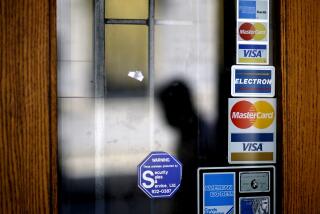THE ECONOMY : Consumer Debt Rises $3.48 Billion : Autos, Apparel Purchases Big Factors in August Rebound
- Share via
WASHINGTON — Americans took out $3.48 billion more in consumer debt than they retired in August, the government reported Friday, resuming their borrowing practices after reducing their debt in July for the first time in 2 1/2 years.
Analysts had said the July debt liquidation was a one-time thing and forecast continued borrowing in the foreseeable future.
“We really haven’t become a nation of big savers,” said economist Sandra Shaber of the Futures Group, a Washington forecasting firm. “People aren’t tearing up their credit cards.”
The Federal Reserve Board said consumer credit in August increased at a seasonally adjusted annual rate of 6%, compared to July’s revised decrease of 0.9%, which was even steeper than the 0.5% originally reported.
The decline in July was the first since January, 1987, when consumer debt fell $1.63 billion, or 3.4%.
For all of 1988, consumer credit climbed 8.5%.
The August debt rebound had been expected in part because of robust automobile sales propelled by end-of-model-year sales incentives and the threat of steep price increases for 1990 models.
Auto loans, which fell 6.9% in July and 2.3% in June, grew by $400 million in August, or 1.7% on an annual rate. Auto loans had declined $1.67 billion in July.
Shift in Buying
The category of debt that includes credit cards rose by $3.57 billion in August, resuming a sharp 22.5% annual rate of increase. It had risen only 8.9% to $1.41 billion in July, down from a 20.1% hike in June.
“People are shifting now from things like cars and other major durables to soft goods” such as clothing, Shaber said. “This reflects a shift in household spending patterns that has been going on for the past year.”
Consumer spending, which represents two-thirds of all economic activity, is watched closely as a sign of economic health, particularly in light of Fed efforts to contain inflation by slowing the economy--but without driving it into a recession.
The Federal Open Market Committee, the Fed’s monetary policy-making body, met earlier this week to determine credit strategy for the coming weeks. Its decision will not be disclosed publicly for six weeks.
Nevertheless, analysts did not expect any major changes in central bank policies and look for interest rates to continue at their current level for much of the remainder of the year.
Bank and credit union loans not secured by real estate rose by $158 million, a 1% annual rate of growth. That compared to a 1.1% decline in July.
Mobile home debts continued to fall, down a whopping $656 million or a 33.3% annual rate of decline. This category has fallen for seven consecutive months including a July drop of $56 million, or 2.8%.
The various changes left total consumer debt in August at a seasonally adjusted $703.8 billion.
More to Read
Inside the business of entertainment
The Wide Shot brings you news, analysis and insights on everything from streaming wars to production — and what it all means for the future.
You may occasionally receive promotional content from the Los Angeles Times.










